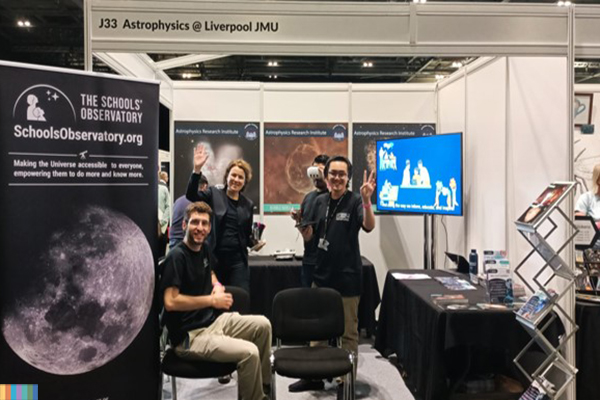LIV.INNO astrophysicists attend New Scientist Live outreach event

A team of researchers from Liverpool John Moores University, including staff and students from the LIV.INNO CDT, have presented their work at ‘New Scientist Live’ which took place at the ExCeL Centre in London. More than 3000 people visited the LJMU stand over the course of the three-day event which was open to the public on first two days and was targeted at school groups on its final day.
The team was led by LIV.INNO Deputy Director Dr Andreea Font and LIV.INNO was advertised at this event to potential future students. There were many students who were interested in discussing the work of the CDT with regard to their future careers. Dr Font said: “New Scientist Live is one of the greatest festivals of science in the world. We were amazed by the enthusiasm with which the public responded to our activities and the great curiosity surrounding everything that relates to space.”
The team were bombarded with questions from curious visitors throughout the three-day event, wanting to know about everything from dark matter and black holes to exoplanets and aliens. As ever the young children who attended came up with the best questions and many went away from the event wanting to become astronomers!
The activities available to the visitors each day included a simulation of the Universe in Virtual Reality which LIV.INNO student Sakircan Beyazit is using as part of his PhD project. Computer apps where visitors could create their ‘own Universes’, and or could manoeuvre a 3D printed version of the Liverpool Telescope to make observations were also used.
Sakircan said: “Activities such VR provide us with a good medium to share our research with the public as it paints a simple general picture where people can see with their own eyes, interact with it and actually experience it first-hand. Sometimes our research can become a bit too abstract working with numbers and statistics, but such activities put it into a nice perspective which is more accessible to the public.”
LIV.INNO student Khang Nguyen also attended and he said: “There were quite a few people who were on the verge of picking their GCSEs and A-levels and who would ask us about our journey in astrophysics and what careers are available, to which we would give them an insight on our own journeys, how things went for us and the myriad of things they could do with what they learn in astronomy. This is where I definitely recommended the LIV.INNO scheme and its support in industrial placements in data science to be a potential avenue in the careers of astrophysicists.”